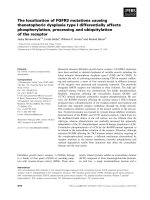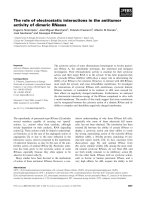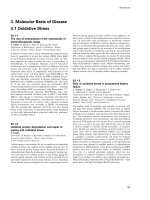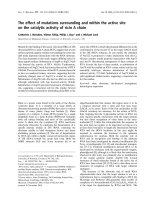Báo cáo khoa học: "The rate of Salmonella spp. infection in zoo animals at Seoul Grand Park, Korea" docx
Bạn đang xem bản rút gọn của tài liệu. Xem và tải ngay bản đầy đủ của tài liệu tại đây (240.73 KB, 5 trang )
JOURNAL OF
Veterinary
Science
J. Vet. Sci. (2008), 9(2), 177
181
*Corresponding author
Tel: +82-2-450-3709; Fax: +82-2-454-3709
E-mail:
The rate of Salmonella spp. infection in zoo animals at Seoul Grand
Park, Korea
Y. H. Jang
1
, S. J. Lee
1
, J. G. Lim
1
, H. S. Lee
2
, T. J. Kim
1
, J. H. Park
1
, B. H. Chung
1
, N. H. Choe
1,
*
1
College of Veterinary Medicine, Konkuk University, Seoul 143-701, Korea
2
National Veterinary Research and Quarantine Service, Anyang 430-856, Korea
Salmonellosis is an important zoonotic disease that af-
fects both people and animals. The incidence of reptile-as-
sociated salmonellosis has increased in Western countries
due to the increasing popularity of reptiles as pets. In
Korea, where reptiles are not popular as pets, many zoos
offer programs in which people have contact with animals,
including reptiles. So, we determined the rate of Salmonella
spp. infection in animals by taking anal swabs from 294
animals at Seoul Grand Park. Salmonella spp. were iso-
lated from 14 of 46 reptiles (30.4%), 1 of 15 birds (6.7%)
and 2 of 233 mammals (0.9%). These findings indicate that
vigilance is required for determining the presence of zoo-
notic pathogen infections in zoo animals and contamina-
tion of animal facilities to prevent human infection with
zoonotic diseases from zoo facilities and animal exhibi-
tions. In addition, prevention of human infection requires
proper education about personal hygiene.
Keywords: reptile-associated salmonellosis, salmonella, zoo an-
imal, zoonotic disease
Introduction
Salmonellosis is one of the most important zoonotic diseases
that affect both people and animals [6]. For example, the
Center for Disease Control and Prevention (CDC) in the
United States has estimated that Salmonella caused 1.4
million episodes of infection between 1999 and 2003, with
over 7% of these infections caused by reptile-associated
salmonellosis. Reptiles have become increasingly common as
domestic pets, and there has been an associated increased
incidence of reptile-associated Salmonella infection in
humans [5,14,17]. Reptiles are asymptomatic carriers of
Salmonella infection, and they intermittently excret these
organisms in their feces [1].
Salmonella infections can be fatal in humans, and especially
for those who are immature or immunocompromised, in-
cluding babies, children younger than 5 years of age, pregnant
women, elderly people and people with AIDS. The US
CDC has recommended that these individuals should
avoid contact with reptiles and that they should not keep
pet reptiles in their homes [8,17].
Since reptiles are not popular pets in Korea, people most
frequently come into contact with reptiles in zoos. In
modern zoos, animals are kept in more natural environ-
mental surroundings, with harmless animals, including
nonpoisonous reptiles and docile mammals, often allowed
to roam freely in natural looking exhibits. In particular,
there are no fences, so visitors can touch these animals and
make contact with the animals’ feces and their living
environment. Furthermore, many events at zoos allow
visitors to become more familiar with the animals. In
addition to direct transmission via animals to humans,
Salmonella, which is relatively resistant to the environ-
ment, can be indirectly transmitted to humans through
contact with the infected exhibit furnishings. For example,
39 children who attended a Komodo dragon exhibit at the
Denver Zoo in Colorado in 1996 became infected with
Salmonella, although none touched the animals [1,4]. In
the Denver Zoo case, only a fence separated the visitors
from the Komodo dragons and the dragons were allowed to
wander freely behind the fence, suggesting that the 39
children became infected by contact with the Salmonella
infected wooden barrier.
In addition to reptiles, mammals in a zoo can be infected
by Salmonella spp. Moreover, if one animal in an exhibit or
cage is infected, then it can transmit the infection to all the
other animals in the same exhibit or cage [14]. Further-
more, animals in an outdoor exhibit can be contaminated
with Salmonella by contact with wild animals (e.g. birds,
rats etc.) [10]. To determine the risk of Salmonella infec-
tion from human-to-animal contact in Korea, we assessed
the rate of Salmonella spp. infection for the animals kept at
Seoul Grand Park, Korea.
178 Y. H. Jang et al.
Tabl e 1 . Distribution of the examined samples from the animals in Seoul Grand Park
Classification Common name Scientific name No. of samples
Class Reptilia
Order Testudinata
Order Squamata
Class Aves
Class Mammalia
Order Endentata
Order Perissodactyla
Family Equidae
Order Rodentia
Order Primates
Asian giant terapia
Red-eared slider
Reeve's turtle
Burmese python
Green iguana
Dione's rat snake
Indian python
Korean rat snake
Mangrove snake
Reticulated python
Yellow anaconda
Blue-and-yellow macaw
Golden pheasant
Great hornbill
Indian peacock
Silver pheasant
Six-banded armadillo
Miniature horse
Przewalski horse
Porcupine
Anubis baboon
Black spider monkey
Black-handed spider monkey
Bonnet monkey
Brown capuchin
Celebes macaque
Crab eating macaque
De Brazza's monkey
Formosan macaque
Lion tailed macaque
Mandrill
Mangabey
Mona monkey
Moor monkey
Orangutan
Patas monkey
−
Trachemys scripta elegans
Geoclemys (Chinemys) reevesii
P
ython molurus
I
guana iguana
E
laphe dione
P
ython molurus
E
laphe schrenckii
B
oiga dendrophila
P
ython reticulatus
E
unectes notaeus
A
ra ararauna
Chrysolophus pictus
B
uceros bicornis
P
ovo cristatus
Gennaeus nycthemerus
E
uphractus sexcinctus
E
quus caballus przewalskii
E
quus przewalskii przewalskii
−
P
apio anubis
A
teles paniscus
A
teles geoffroyi
M
acaca radiata
Cebus apella
M
acaca nigra
M
acaca fascicularis
Cercopithecus neglectus
M
acaca cyclopis
M
acaca silenus
P
apio (Mandrillus) sphinx
Cercocebus albigena
Cercopithecus mona
M
acaca maura
P
ongo pygmaeus
E
rythrocebus patas
1
8
2
3
8
2
4
1
9
2
6
4
4
1
3
3
5
8
5
7
3
3
1
3
2
4
5
5
1
1
1
2
2
1
2
2
Materials and Methods
Sample collection
From September to October 2006, fecal samples were
obtained by anal or cloacal swabs from 294 animals (46
reptiles, 14 birds and 233 mammals) housed at Seoul
Grand Park, Korea (Table 1). The swabs were placed in
sterile Ames transport medium (Difco, USA) and they
were stored at 4
o
C for 24-48 h prior to processing.
Isolation of Salmonella
The samples were selectively enriched for Salmonella by
incubating the swabs in tetrathionate broth (Difco, USA) at
37
o
C for 24-48 h. The selective enrichment cultures were
streaked onto Salmonella Chromogenic Agar (Oxoid, UK)
and this was incubated at 37
o
C for 24 h [3].Violet colored
colonies suspected of being Salmonella spp. were ino-
culated onto API20E biochemical profiles (bioMerieux
SA, France).
Antimicrobial resistance test (re-isolation after
freezing)
The 15 Salmonella isolates were grown from 17 stocks.
The stocks were made after first isolation in this experi-
Rate of Salmonella spp. infection in zoo animals
179
Tabl e 1 . Continued
Classification Common name Scientific name No. of samples
Order Primates
Order Artiodactyla
Family Camelidae
Family Cervidae
Family Bovidae
Pig tailed monkey
Rhesus Macaque
Savannah monkey
Toque monkey
White faced Capuchin
White handed gibbon
White-cheeked gibbon
Guanaco
Lama
One-humped camel
Two-humped camel
Barasingha
Hog deer
Japanese deer
Moose
Red deer
Pere david's deer
Sambar
Yak sika
Dall's sheep
Bighorn sheep
Ibex
Mouflon Sheep
M
acaca nemestrina
M
acaca mulatta
Cercopithecus aethiops
M
acaca sinica
Cebus capucinus
H
ylobates lar
H
ylobates concolor
L
lama guanacoe
L
lama glama
Camelus dromedarius
Camelus bactrianus
Cervus duvaucelii
A
xis porcinus
Cervus nippon
A
lces alces
Cervus elaphus
E
laphurus davidianus
Cervus unicolor
Cervus nippon yakusimae
Ovis dalli
Ovis canadensis
Capra ibex
Ovis musimon
8
6
9
10
2
2
2
10
10
5
3
10
9
4
7
11
9
6
10
10
10
8
9
Total 294
Tabl e 2 . Number of detected Salmonella spp. and the results of serotyping
Common name No. of Samples Salmonella positive Subspecies & serovar (No. of isolates)
Mangrove snake
Green iguana
Yellow anaconda
Indian python
Burmese python
Macaw
9
8
6
4
3
4
4
4
3
2
1
1
S. Newport (3)
S. Oslo (1)
S. Somone (3)
untypable (1)
Salmonella III (2)
untypable (1)
Salmonella III (1)
untypable (1)
Salmonella III
S. Rissen
ment and then were stored in 20
o
C for a year. 5 ml aliquots
of cultured buffered peptone water were inoculated onto
Mueller-Hinton (Oxoid, UK) agar plates with using a
sterilized swab, followed by placing antibiotic discs that
contained ampicillin-sulbactam 20 μg, polymyxin B 300 μ
g, cephalothin 30 μg, tetracycline 30 μg, chloramphenicol
30 μg, gentamicin 10 μg, cefotaxime 30 μg, sulfamethazole-
trimethoprim 25 μg or nitrofuratonin 300 μg onto the agar
plates, respectively. The plates were incubated for 18 h at
35
o
C, and the zones of inhibition were interpreted by the
guideline of the National Committee for Clinical Labora-
tory Standards (NCCLS, 1990).
Serotyping
Fifteen Salmonella spp. positive samples identified with
API20E were serotyped, with using the Kaufmann-White
180 Y. H. Jang et al.
Table 3. Distribution of the Salmonella isolates by the type o
f
animal
Class No. of animals No. of isolates (%)
Birds
Reptiles
Mammals
Total
15
46
233
294
1 (6.7)
14 (30.4)
2 (0.9)
17 (5.8)
Table 4. Antimicrobial susceptibility of the 15 Salmonella isolates
Antimicrobial agent Sensitive isolates Intermediate isolates Resistant isolates
Ampicillin-sulbactam
Polymyxin B
Cephalothin
Tetracycline
Chloramphenicol
Gentamicin
Cefotaxime
Sulfamethazole-trimethoprim
Nitrofuratoin
15 (100%)
15 (100%)
11 (73.3%)
13 (86.7%)
15 (100%)
14 (93.3%)
11 (73.3%)
15 (100%)
13 (86.7%)
0
0
2 (13.3%)
0
0
0
1 (6.7%)
0
2 (13.3%)
0
0
2 (13.3%)
2 (13.3%)
0
1 (6.7%)
3 (20.0%)
0
0
scheme, by the National Veterinary Research Quarantine
Service (Table 2). The presence of Salmonella spp. sub-
species III was confirmed by utilization of malonate broth
(Difco, USA) and the absence of dulcitol fermentation
(Biolife, Italy).
Results
Salmonella spp. was isolated from 17 of the 294 (5.8%)
anal swab samples (from 14 of 46 reptiles (30.4%), 1 of 15
birds (6.7%) and 2 of 233 mammals) (0.9%) (Table 3).
Seventeen isolates were selected according to the bio-
chemical profiles with using API20E. After about a year of
storage at 20
o
C, these 17 Salmonella positive samples
were re-inoculated. This yielded 15 positives, which were
then tested for their antimicrobial susceptibility and
serotype (Tables 2 and 4).
Discussion
Human infection by reptile-associated salmonellosis has
been increasing throughout the world because more people
have started keeping exotic pets, including turtles, snakes
and iguanas [8,12]. In 1975, legislation in the USA banned
the sale of small turtles, which led to an 18% reduction of
salmonellosis in children 1-9 years old [17]. Yet zoo
visitors becoming infected with Salmonella is not com-
mon, although 39 children visiting the Denver zoo in 1996
became infected [7]. Between 1966 and 2000, there have
been 11 published zoonotic disease outbreaks associated
with animal exhibits, as well as 16 unpublished outbreaks
[2]. Therefore, although zoonotic disease outbreaks from
zoos or animal exhibitions are infrequent, zoo visitors and
zookeepers are at risk of infection from animal carriers.
The purpose of this research was to ascertain the rate of
Salmonella spp. rate in zoo animals at Seoul Grand Park,
Korea. Fecal samples were collected from 294 animals (46
reptiles, 15 birds and 233 mammals), and Salmonella spp.
strains were found in 14 (30.4%), 1 (6.7%) and 2 (0.9%) of
these animals, respectively.
Of the 15 Salmonella isolates we examined, 8 belonged to
subspecies I and 4 belonged to subspecies III, with the
other 3 could not be typed. Subspecies I is responsible for
more than 99% of Salmonella infections in humans [16].
Generally, Salmonella subspecies I is found in warm
blooded animals, whereas subspecies II, IIIa, IIIb and IV
are isolated from cold-blooded vertebrates and their
environments. However, the most common subspecies
isolated from reptiles was recently reported to be subspecies
I [8,12].
The most frequent serovar was S. enterica Newport, a
pathogen of growing importance because of its epidemic
spread in dairy cattle and its increasing rate of antimicro-
bial resistance. Between 1987 and 1997, this serotype was
the fourth most common strain seen in human salmonello-
sis cases in the US [13,15]. This serovar was also identified
in Japan as a cause of human gastroenteritis [12]. The S.
enterica Newport isolated in this study originated from
mangrove snakes, suggesting that the prevalence of
Salmonella spp. in reptiles may be caused by asymptoma-
tic carriers. Reptiles could then excrete these organisms
into the environment and so infect zookeepers and other
humans [10]. Evaluation of the environmental spread of
Salmonella strains in the reptile department of the Antwerp
Zoo found contamination of the floor, window benches,
cage furniture, the kitchen used for preparing animal food,
water containers and fences [1], suggesting that people can
Rate of Salmonella spp. infection in zoo animals
181
be infected with Salmonella spp. by indirect transmission
through contaminated environments [4,18].
We also isolated Salmonella spp. from green iguanas.
Iguanas have become more popular as pets and so they play
an important role in reptile-associated salmonellosis [8].
Therefore, zoos should take care prior to offering ‘oppor-
tunities to touch reptiles’ to their visitors.
Although most reptiles at Seoul Grand Park are kept in
their own cages, the turtles and Korean terrapins are kept in
a more natural environment that basically resembles a
small stream. These animals can therefore roam freely
around a fish tank surrounded by rocks and wooden fences,
and visitors can touch these surroundings. In addition,
Burmese pythons are very docile and they are frequently
used in reptile contact programs. Of the 3 Burmese pythons
we tested, 1 was an asymptomatic Salmonella carrier.
Since many zoos have programs in which humans can feed
and touch animals, this can lead to infection of children and
immunocompromised individuals. Fortunately, most of
the isolated Salmonella spp. in our study were susceptible
to most antibiotics.
Our results emphasize the importance of surveillance of
zoonotic bacterial infections in zoo animals. Our findings
also highlight the requirement for better personal hygiene
practices to minimizing the risk of infection for zoo visitors
and the zoo personnel, as well as the need for educating zoo
personal and visitors about proper hygiene practices.
Acknowledgments
This work was supported by the Konkuk University.
References
1. Bauwens L, Vercammen F, Bertrand S, Collard JM, De
Ceuster S. Isolation of Salmonella from environmental sam-
ples collected in the reptile department of Antwerp Zoo using
different selective methods. J Appl Microbiol 2006, 101,
284-289.
2. Bender JB, Shulman SA. Reports of zoonotic disease out-
breaks associated with animal exhibits and availability of rec-
ommendations for preventing zoonotic disease transmission
from animals to people in such settings. J Am Vet Med Assoc
2004, 224, 1105-1109.
3. Cassar R, Cuschieri P. Comparison of Salmonella chromo-
genic medium with DCLS agar for isolation of Salmonella
species from stool specimens. J Clin Microbiol 2003, 41,
3229-3232.
4. Corrente M, Madio A, Friedrich KG, Greco G, Desario
C, Tagliabue S, D'Incau M, Campolo M, Buonavoglia C.
Isolation of Salmonella strains from reptile faeces and com-
parison of different culture media. J Appl Microbiol 2004, 96,
709-715.
5. Centers for Disease Control and Prevention (CDC).
Reptile-associated salmonellosis selected states, 1996-
1998. MMWR Morb Mortal Wkly Rep 1999, 48, 1009-1013.
6. Ebani VV, Cerri D, Fratini F, Meille N, Valentini P,
Andreani E. Salmonella enterica isolates from faeces of do-
mestic reptiles and a study of their antimicrobial in vitro
sensitivity. Res Vet Sci 2005, 78, 117-121.
7. Friedman CR, Torigian C, Shillam PJ, Hoffman RE,
Heltzel D, Beebe JL, Malcolm G, Dewitt WE, Hutwagner
L, Griffin PM. An outbreak of salmonellosis among children
attending a reptile exhibit at a zoo. J Pediatr 1998, 132,
802-807.
8. Geue L, L
öschner U. Salmonella enterica in reptiles of
German and Austrian origin. Vet Microbiol 2002, 84, 79-91.
9. de Jong B, Andersson Y, Ekdahl K. Effect of regulation and
education on reptile-associated salmonellosis. Emerg Infect
Dis 2005, 11, 398-403.
10. Kim KH, Kim KS, Tak RB. The distribution of Salmonella
in mammals in Dalsung Park (Daegu) and genetic inves-
tigation of isolates. Korean J Vet Public Health 2002, 26,
31-37.
11. Kim SY, Lee HM, Kim S, Hong HP, Kwon HI. Phage typ-
ing and pulsed-field gel electrophoresis of Salmonella typhi-
murium and S enteritidis isolated from domestic animals in
Gyeongbuk province. Korean J Vet Serv 2001, 24, 243-253.
12. Nakadai A, Kuroki T, Kato Y, Suzuki R, Yamai S,
Yaginuma C, Shiotani R, Yamanouchi A, Hayashidani H.
Prevalence of Salmonella spp. in pet reptiles in Japan. J Vet
Med Sci 2005, 67, 97-101.
13. Olsen SJ, Bishop R, Brenner FW, Roels TH, Bean N,
Tauxe RV, Slutsker L. The changing epidemiology of
Salmonella: trends in serotypes isolated from humans in the
United States, 1987-1997. J Infect Dis 2001, 183, 753-761.
14. Schr
öter M, Roggentin P, Hofmann J, Speicher A, Laufs
R, Mack D. Pet snakes as a reservoir for Salmonella enterica
subsp. diarizonae (Serogroup IIIb): a prospective study. Appl
Environ Microbiol 2004, 70, 613-615.
15. Tappe D, M
üller A, Langen HJ, Frosch M, Stich A.
Isolation of Salmonella enterica serotype Newport from a
partly ruptured splenic abscess in a traveler returning from
Zanzibar. J Clin Microbiol 2007, 45, 3115-3117.
16. Uzzau S, Brown DJ, Wallis T, Rubino S, Leori G, Bernard
S, Casades
ús J, Platt DJ, Olsen JE . Host adapted serotypes
of Salmonella enterica. Epidemiol Infect 2000, 125, 229-255.
17. Wells EV, Boulton M, Hall W, Bidol SA. Reptile-associated
salmonellosis in preschool-aged children in Michigan,
January 2001-June 2003. Clin Infect Dis 2004, 39, 687-691.
18. Woodward DL, Khakhria R, Johnson WM. Human salmo-
nellosis associated with exotic pets. J Clin Microbiol 1997,
35, 2786-2790.
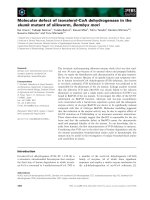
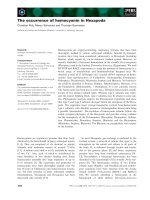
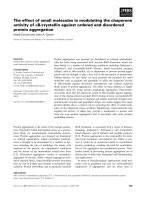
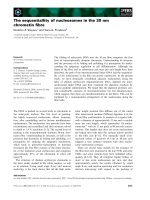
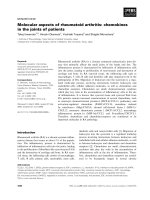
![Tài liệu Báo cáo khoa học: The stereochemistry of benzo[a]pyrene-2¢-deoxyguanosine adducts affects DNA methylation by SssI and HhaI DNA methyltransferases pptx](https://media.store123doc.com/images/document/14/br/gc/medium_Y97X8XlBli.jpg)
